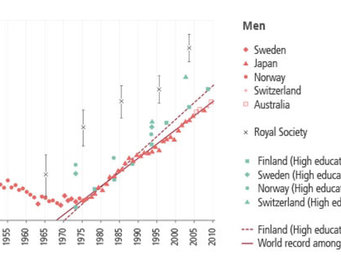Life expectancy: trends among the highly educated show the way
Higher education levels can reduce mortality especially in older people
Over the last century, life expectancy rose on average by three months a year. However, this progress has been uneven across educational groups. Highly educated people who systematically display the highest life expectancy levels have been the vanguards leading the way towards a lengthening of life for the remaining population groups. This trend has inspired scholars from the Max Planck Institute for Demographic Research to point out that there is considerable potential for the life expectancy values of entire populations to increase further.

The pattern is the same in almost every country: people who are highly educated live longer on average than people who are less educated. Indeed, in some countries the life expectancy levels of the highly educated exceed the world record life expectancy values at the country level that have been reached in countries like Japan or Switzerland. Domantas Jasilionis and Vladimir M. Shkolnikov of the Max Planck Institute for Demographic Research in Rostock have attempted to provide an international overview of this topic in an article that was published in the April issue of the journal Gerontology, and in a shorter version of this article that appears in the current issue of Demografische Forschung aus Erster Hand.
Gaps are especially large in Russia
International evidence suggests that some selective population groups may reach extremely high life expectancy values. For example, studies conducted in the U.S. and Norway have shown that small religious groups like the Mormons and the Seventh-day Adventists have achieved life expectancy levels that are much higher than the average levels in the countries with the highest life expectancy values in the world. Research findings also indicate that life expectancy levels are very high observed among the members of academic organizations like the Royal Society in Great Britain and the national academies of Germany, Austria, and Russia. Importantly, mortality among these scientific elites has been declining faster than the corresponding national averages, even though these groups already had record-low mortality levels at the start of the study period. Similar evidence also comes from mortality studies that looked at mortality among much larger and more conventional population groups, including educational groups.
The European studies on educational differentials show that the life expectancy differences between educational groups have grown in recent decades. Life expectancy has been increasing more rapidly among the highly educated than among the less educated segments of the population in the Scandinavian countries, as well as in Finland, Belgium, France, and Switzerland. In addition, very large and growing gaps between educational groups have been observed in central and eastern European countries, and especially in Lithuania, Estonia, and Russia. An extreme example of this pattern can be seen by looking at the life expectancy projections for Russian men. At the turn of the century, the life expectancy gap between the men with the highest and the lowest educational levels was around 13 years in Russia.
While the overall situation in the U.S. is similar to that of western and northern Europe, it is notable that in the U.S. life expectancy among women varied considerably by social class in the 1980s and the 1990s. Indeed, a number of studies found that the average life expectancy actually declined among the least educated non-Hispanic white women.
Cardiovascular revolution benefits the highly educated
Across all educational groups, gains in life expectancy can be attributed to decreases in mortality at older ages. Mortality among older people has been declining since the 1960s and the 1970s, largely because of improvements in the treatment of heart and circulatory diseases that are collectively referred to as the “cardiovascular revolution.” When we look at the contributions of the age groups to these educational group differences, it is clear that the highly educated benefited from this revolution the most. For example, among Finnish men the difference between the highly educated and the other educational groups was 4.4 years in the 1970s; at that time, only one-third of this mortality gap was attributable to lower mortality after age 65. Some 35 years later this gap has expanded to six years, and around 2.5 of these years are attributable to lower mortality among the highly educated at old ages.
Early deaths are preventable
These large advances in life expectancy among the highly educated suggest that there is still considerable potential for life expectancy improvements among the middle and lower social classes. The unfavourable trends in life expectancy among the less educated that have been observed in some countries are avoidable, as they are largely caused by preventable early deaths.
Improvements in the educational attainment levels of populations are also contributing to further increases in life expectancy. For example, around half of the total increase in life expectancy among 30-year-old Swedish men between 1988 and 1999 can be traced back to improvements in the educational attainment levels of the Swedish population as a whole. This trend could also play out in many other countries.
The authors pointed out, however, that average life expectancy is unlikely to converge to the record values observed among the highly educated unless more progress is made in the fight against old -age- related diseases, such as Alzheimer’s disease. Furthermore, the life expectancy improvements associated with higher levels of educational attainment may be counteracted by the negative effects of other compositional factors, such as an increase in the share of people who are divorced, or further growth in the proportion of people who are overweight or who smoke.
AE












